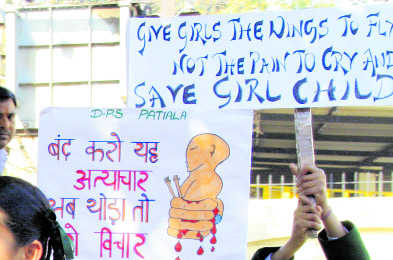
Placards with messages to save the girl child. Tribune photo: Rajesh Sachar
Manish Sirhindi
Tribune News Service
Patiala, September 23
Busting the myth yet again that educated people in cities across the country are promoting girl child, nine villages in the district have shown the way for others by registering the higher child sex ratio (CSR) in favour of girl child. Gharam village of the district is leading the charts with 1,579 girls per 1,000 boys.
The Annual Health Survey (AHS) has long established that the urban areas are recording a decline in female birth rate, while the rural areas are doing far better to protect the girl child.
Corroborating the fact, a recent survey conducted by the district health authorities and the district programme officer found that besides Gharam village, Harpalpur village registered a CSR of 1,361 girls per 1000, Chirdwa village has CSR 1,349 girls, Chounth village in Shutrana segment has CSR 1,301 girls, Dargahpur village has CSR 1,294, Ghazipur village has CSR 1,222 girls, Hari Majra village registered a CSR of 1,200 girls and Tohra village has 1149 girls per 1,000 boys.
Deputy Commissioner Ramvir Singh said the District Administration had decided to honour the panchayats with a cash award of Rs 25,000 each.
It was under the joint initiative between the Ministry of Women and Child Development, the Ministry of Health and Family Welfare and the Ministry of Human Resource Development that Prime Minister Narendra Modi had launched the “Beti Bachao Beti Padhao” campaign. Under this campaign, the villages in the district have been performing well.
The campaign had been designed to reverse the trend of declining child sex ratio (CSR) in the country. According to Census 2011, national CSR plunged from 945 in 1991 to 927 in 2001 and 919 in 2011.
The government aimed at preventing the practice of sex selection before or after conception, deterring the use of diagnostic techniques for sex determination leading to female foeticide, mobilising local communities and sensitising them to the need for healthier child sex ratios, promoting universal school enrolment and reducing the school dropout rates of girl children.
Sex determination and female foeticide have been partly blamed for the low CSR in Rohtak and elsewhere in Haryana, although sex selection was outlawed by the Pre-Conception and Pre-Natal Diagnostic Techniques (Prohibition of Sex Selection) Act, 1994.



























